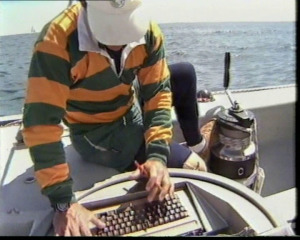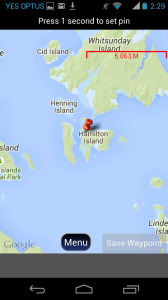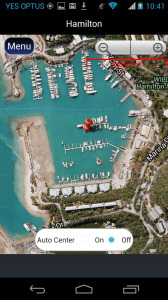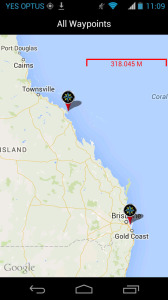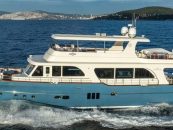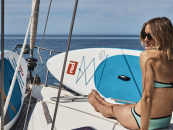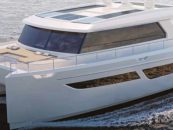I was seventeen when I started sailing. It was in the Jubilee, a tubby centreboard craft, eighteen feet (about 5.5m) long, with a crew of four. Designed in Port Philip Bay, it was virtually unsinkable. (I believe that there is, today, a fleet of five Jubilees in Redland Bay, Qld.)
I was also seventeen when I encountered Siliac, a computer built at Sydney University and installed in 1956. It was in use in 1961 when I enrolled.
The notion of using that computer on board a Jubilee was laughable. Not only did it weigh a multiple of the weight of the Jubilee, but it was several times as large. It required air-conditioning and its power requirements were immense. Anyone who made the attempt would have destroyed the reputation of the Jubilee as being unsinkable!
Iain Murray’s tactician working on the computer we donated for use as navigational aid on board Kookaburra III for the 1987 America’s Cup. The use of the computer was successful; unfortunately, the defence was not.
Today, the scene is radically different. It is now possible to have many times the computing power of Siliac on board a Jubilee. Computers are used on boats, both as stand-alone devices and as ancillary to another device. But for this article, I am going to discuss their use as navigational aids.
I am going to start with a class of computers that rival the computing power of many a mainframe of yesteryear…
…The smart phone
On my smart phone, I have installed a navigational system. Please note the “Menu” button, on the bottom of Screenshot No.1, which is that of the main screen. I am going to take you through one of the basic actions in navigation: setting a waypoint.
Screenshot No.2 shows the menu that comes up after pressing the “Menu” button. I choose “Create Waypoint”. Because I know the coordinates of my first waypoint (-27.6108546ᵒ, 153.3082910ᵒ), I choose the “Use Keyboard” method. I save it as “RedlandBay”.
For the second waypoint, I am going to use the “Use Map” option. The useful map options include (a) Downloaded Maps, and (b) Google Maps in Satellite and Map View. I am going to use Google Map View (Screenshot No.3). I choose Hamilton Island harbour, and I save it as “Hamilton”. The two waypoints are now on the map. I can zoom in, as shown in Screenshot No. 4, which I display in Satellite view, and I can zoom out as shown in Screenshot No 5.
I can now go into various functions and establish the distance between the two waypoints and choose “Go to Waypoint”– assuming I have a clear view of the sky to enable my phone to pick up the GPS satellite signals and establish the remaining distance, the heading, the speed, the remaining time and the ETA. Screenshot No.6 shows me going to Redland Bay.
For the price of my smart phone, I can get into a Jubilee at Redland Bay and take it to Hamilton Island, enjoying all that computer power and also testing my claim about its unsinkability.
Why use a “real” computer?
Well, a PC offers a much bigger screen for output, and a keyboard for input. It also offers integration with other devices and specialist computers.
A key requirement of navigation, is knowing where you are at the moment. I am reminded of a joke: “An airplane pilot makes an announcement – Ladies and Gentlemen, I’ve got some good news and some bad news. The bad news is – we’re hopelessly lost. But never fear, the good news is – we’re making excellent time.”
GPS is committed to providing an accuracy, subject to the quality of the GPS receiver, of 7.8m (at a 95% confidence level). That accuracy can be improved by using augmentation systems. Other improvements are the quality of the charts, which require a lot more data—the integration of wind and tide data and devices that measure speed and acceleration. Speed and acceleration are important in racing because one cannot feel the difference between 8.05 knots and 8.15 knots, nor can one feel the acceleration between them. But that tiny difference can result in a yacht coming in a mile behind, or ahead, over the entire course. Specialist stuff, sure, but it must be mentioned.
In the meantime, I am content using my smart phone for the purely recreational sailing I still enjoy.
By Nick Ramensky
Nick Ramensky was the Director of Marketing at Digital Equipment Corporation for 16 years before moving on to pursue a career as a freelance marketing consultant and business strategist. Nick also writes for ThePCDoctor.com.au and never gave up his love of sailing.





















